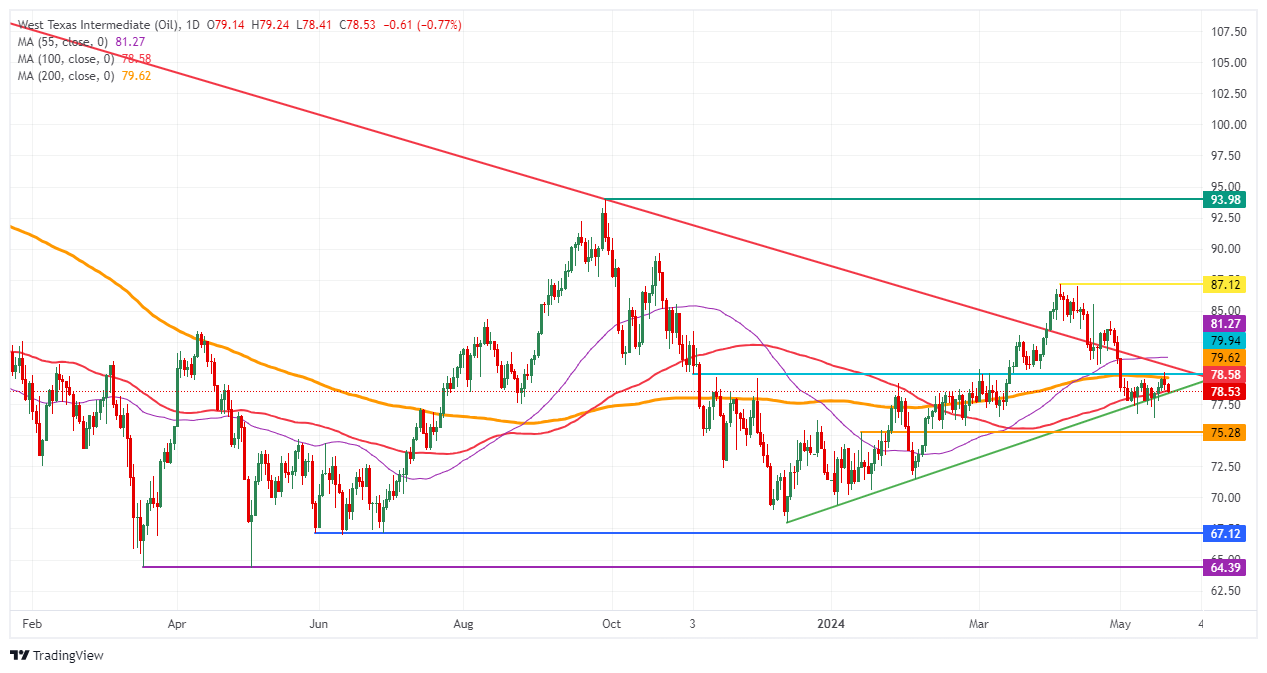Oil remains a big issue for further upside, losing interest with investors due to OPEC’s production surplus.

- Oil broke support for the 2024 rally again on Tuesday.
- The market ignores the current situation because there is no risk to production in the Middle East.
- The US dollar index is looking for direction after being stuck in a tight range at the start of the week.
Oil prices began accelerating their decline on Tuesday, testing market confidence and support for the possibility of further upside. Traders don’t place any weight or importance on risk on the two major headlines from Monday and today. On one side, the funeral of the Iranian president who crashed in a helicopter accident is being held. The second is an international arrest warrant from the International Criminal Court for Israeli leader Benjamin Netanyahu and Defense Minister on war crimes charges.
Meanwhile, the US Dollar Index (DXY), which tracks the performance of the greenback against six major currencies, is finding direction ahead of Nvidia earnings on Wednesday as the market flips between risk-on and risk-off. . With another big Federal Reserve speech scheduled for Tuesday, it feels like every Fed member is ‘playing and repeating.’ Therefore, there is likely no new insight that could suggest the exact timing of the Fed’s initial rate cut.
At the time of this writing, crude oil (WTI) is trading at $77.92 and Brent crude oil is trading at $82.32.
Oil news and market movers: The action will come from gas, not oil.
- FGE Chairman Fereydoun Pesharaki, a leading industry consultant to the oil and gas market, said at an event in Dubai that OPEC’s spare production capacity would not be needed in 2024 and the market should brace for disruption in the LNG market. .
- Several countries have issued warnings over the helicopter crash that killed Iran’s president and asked them to remain on high alert for possible retaliation.
- Reuters reported that US President Joe Biden fiercely criticized the International Criminal Court in support of his ally Israel.
- Bloomberg News reported that President Vladimir Putin said that Russia’s oil production in early 2024 decreased by 1.8% compared to the same period last year.
- At 20:30 GMT, the American Petroleum Institute (API) is scheduled to release weekly U.S. crude oil inventory change figures for the week ending May 17 on Tuesday. The previous figure was a decrease of 3.104 million barrels.
Oil Technical Analysis: Oil to Be Traded in 2024
Oil prices have been testing the upward trendline again from December lows for almost three weeks in a row. Despite numerous headlines coming from the Middle East, traders do not flag any events or headlines as a risk of disruption to the region’s oil supplies or global trade. This causes oil traders to miss out on the commodity rally taking place in precious metals and gas futures.
Meanwhile, the line in the sand remains at the 200-day simple moving average (SMA), which is currently at $79.62. Above that level we see a double layer with a 100-day SMA at $78.58. If extended upwards over that section, the road would reopen at $87.12.
The downside is that the important level of $75.28 is the last solid line that could end this downtrend. If this level cannot be maintained, investors can expect an accelerated selloff towards $72.00 and $70.00. That would wipe out all gains in 2024. A further decline could cause oil prices to test the December 13 low of $68.

US WTI Crude Oil: Daily Chart
WTI Oil FAQs
WTI oil is a type of crude oil sold on international markets. WTI is an abbreviation for West Texas Intermediate, one of the three major crude oils, including Brent and Dubai crude. WTI is also called “light” and “sweet” because of its relatively low specific gravity and low sulfur content, respectively. It is considered a high-quality oil that is easily refined. It is sourced from the United States and distributed through the Cushing hub, considered the “pipeline crossroads of the world.” This is the benchmark for the oil market and WTI prices are often quoted in the media.
As with all assets, supply and demand are the main drivers of WTI oil prices. Therefore, global growth can be a driver of increased demand, and vice versa, a driver of weakening global growth. Political instability, war and sanctions can disrupt supply and affect prices. Decisions by OPEC, a group of major oil producers, are another key driver of prices. The value of the US dollar affects the price of WTI crude oil. This is because oil is traded primarily in US dollars. Therefore, a weaker US dollar could make oil cheaper and vice versa.
Weekly crude oil inventory reports published by the American Petroleum Institute (API) and the Energy Information Administration (EIA) influence the price of WTI crude oil. Changes in inventory reflect fluctuations in supply and demand. If data shows inventory declines, it could mean increased demand, pushing oil prices higher. High inventories can push prices down, reflecting increased supply. API reports are published every Tuesday and EIA reports are published the following day. These results are generally similar, coming within 1% of each other 75% of the time. EIA data is considered more reliable because it is a government agency.
OPEC (Organization of the Petroleum Exporting Countries) is an organization of 13 oil-producing countries that jointly determine production quotas for member countries through meetings twice a year. Their decisions often affect WTI oil prices. If OPEC decides to lower quotas, oil prices could rise due to supply shortages. When OPEC increases production, it has the opposite effect. OPEC+ refers to an expanded grouping that includes 10 additional non-OPEC countries, the most notable of which is Russia.
(This story has been corrected to say Nvidia’s earnings report is scheduled for Wednesday at 11:23 GMT.)
Source: https://www.fxstreet.com/news/oil-eases-further-after-string-of-technical-rejections-202405211030



